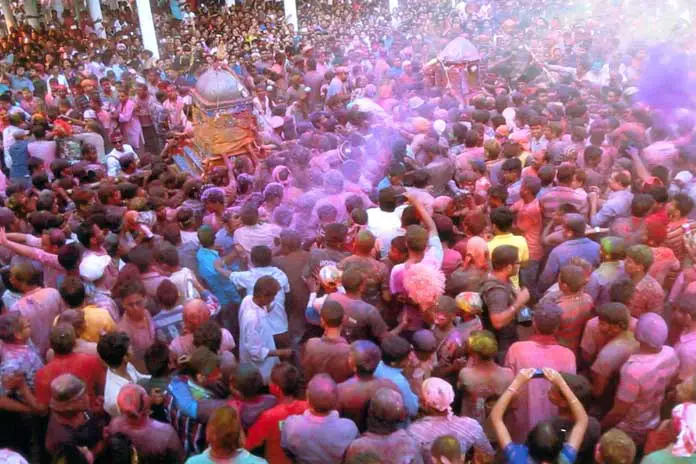The National Award winning film director-editor Ranjit Das, who started his career with noted filmmakers D’bon Barua and Jahnu Barua, has made a fascinating documentary on the traditional Deul or Doul Utsav, titled ‘Holi – The Spirit of Colours’, which was recently nominated in the 9th Jaipur International Film Festival 2017 and the 7th Dada Saheb Phalke Film Festival 2017, New Delhi. Das’s achievements in cinema have been familiar to some extent to critics and audiences alike with films like ‘Pratyavartan’ (1993) and ‘Sanskar’ (1997) to his name. The latter, premiered at the Kolkata Film Festival, received three State Awards in 1999. But the film that earned him a well-deserved reputation came in the way of the aesthetically vivid ‘All Alone If Need Be’, a documentary film, which received the National Award for the ‘Best First Non-Feature Film of a Director’, in 1996. The film had been selected to various film festivals in India and abroad. Another documentary – ‘Return of the Dead Bird’ was screened at the Mumbai International Film Festival (MIFF) in 2008. He has also served on the National Film Awards Jury twice.
The vitality and radiance of Holi or Doul Utsav, locally known as Deul, the enormously popular and colourful festival, celebrated with tremendous pomp and joy every year during the Spring time, truly represents a unique part of Barpeta Satra, one of the most revered Vaishnavite centres of Assam. There has, of course, always been an enormous inflow of devotees to the Barpeta Satra, which amply manifest the Vaishnava character. More than being just a place of worship, the Satra’s religious manuscripts are valued as aids to cognitive learning, while its cultural activities are seen as a levelling and unifying force.
It was Mahapurush Srimanta Sankardeva’s most trusted disciple Madhavdev who established the Barpeta Satra in 1583 AD. Shree Shree Mathura Das Burah Ata took charge as the Burah Satriya (Chief Monk) of Barpeta Satra in 1595 AD. And in 1596 AD, he started Doulotshav within the Satra precincts. Under the guidance of Mathura Das Burah Ata, Vrindavani Vastra was intricately woven by a host of disciples of this satra, depicting scenes from Sri Krishna Leela, which had been designed by Srimanta Sankardeva.

Though present in most Vaishnava satras of Assam, Barpeta Satra’s Deul surpasses them all with its uniqueness and grandeur. In the month of Chot, Deul is celebrated for three days, which is called Burha Deul and the Deul that is observed for four to five days, in the month of Phalgun is called Deka Deul.
The first day of the Deul, called Gandha or Bahnutsav, which is referred to as the ‘festival of bonfires’, starts with a Namprasanga in the morning. The idols of the satra – Dol-Gobinda and Kaliya Thakur, are immaculately dressed with new costumes and ornaments, and brought out from the Monikut to the courtyard. Devotees celebrate the occasion by playing the khol and by lighting locally made fire-crackers.
The second day of Deul is known as Bhor-Deul – meaning main Dol. Bhor Deul is celebrated for just one day in the month of Chot and two three days in the month of Phalgun. The idols are coloured with faku on this day.
The last day of the Deul is called Suweri or Fakuwa. On this special day, the idol of Ghunusha also makes an appearance from the nearby Baradi Satra, and gets to meet Dol-Gobinda and Kaliya Thakur. Devotees of every age and gender, irrespective of caste, creed and community celebrate with a spontaneous expression of joy by playing with coloured powder and singing Holi songs in unison, that really heighten the spirit of the festival.
Holi songs are a unique literary and musical contribution of the cultural heritage of Barpeta Douljatra. The divine music and the rhythm of Holi reverberate in the hearts of the devotees. Written in a religious lyrical style, the Holi songs generally focus on the natural beauty of the Spring season, while at the same time, it also depicts the legend of Radha-Krishna, and their enduring love affair. But Barpeta’s Douljatra is mostly Krishna-centric, as the Assamese Vaishnavite movement does not give that much importance to the character of Radha. Bamboo crashing is also one of the most interesting parts of the last day of Doul Utsav.

All this is colourfully and authentically projected in ‘Holi – The Spirit of Colours’ by director Ranjit Das, who was awed by Barpeta Satra’s cultural vitality. The unique traditional Deul performed with sacred rituals and distinct local flavours will, perhaps, acquaint audiences with our rich and colourful tradition in other parts of the country and abroad, through this documentary. ‘Holi – The Spirit of Colours’ is produced by Debajit Kalita under the banner of UCK Production. Besides directing, Ranjit Das has also designed and written the script. The film’s cinematography has been done by Himangshu Barman, Pranab Medhi and Phulan Das. While the location audiography has been done by Manjit Nath, the 5.1 audio mixing has been conducted by Faruk Iqbal and Chungkham Ingo. The film’s research has been done by Ranjit Das and Manturaj Das, while the narration has been written by eminent writer Munin Bayan, and is narrated by actor Bibhuti Bhushan Hazarika. The English sub-titles are penned by noted writer Dr. Bipuljyoti Saikia. Ranjit Das is assisted in direction by Manturaj Das, while Sanjib Das has worked as the production manager.

